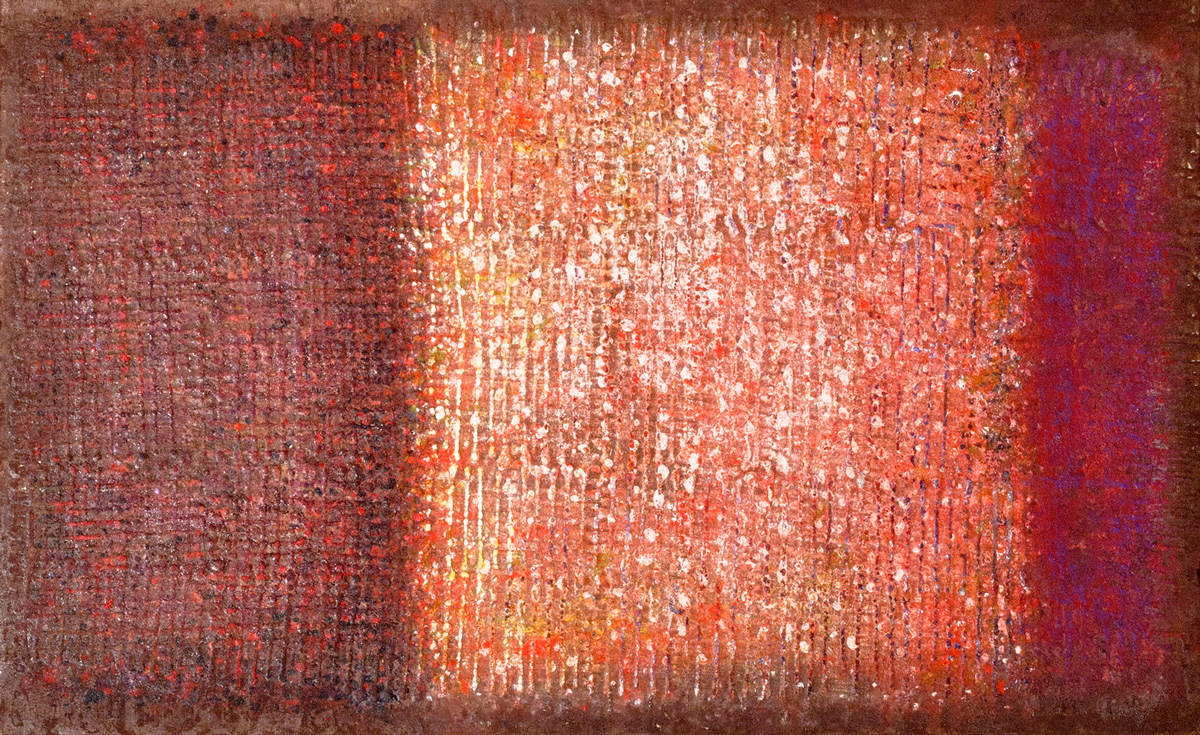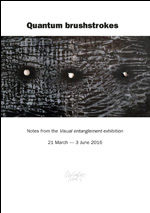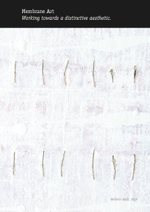I’m honoured to be selected as a finalist in the Open Category of the Waterhouse Natural Science Art Prize™ 2018 for my piece ‘Oxygen Captured’.
This is the third time I have been selected as a finalist in this prestigious exhibition. My entry ‘Oxygen Captured’ represents a single oxygen atom. By representing this atom at a human scale, I hope it will highlight the precious qualities oxygen has for our existence. However, the below image is not the side you will see on display. It is intended as an insight into my ‘hole’ working method. Illustrating how I can work on both sides of the canvas as one ‘complete’ expression — an aesthetic I call Quantum Brushstrokes. And an Artistic Approach that I consider is neither painting nor sculpture.

The reverse side of Oxygen Captured: The above image shows my working notes. Although this side is not on display, it illustrates my working method. An approach that I believe creates works of art that is neither a painting nor a sculpture. Front side is on display at the Waterhouse Natural Science Art Prize™.
See for yourself — the front side will go on display, with all the other selected finalists’ works, at the Waterhouse Natural Science Art Prize™ finalists’ exhibition, South Australian Museum from June 8 until August 5, 2018.
‘I’m re-imagining our universe — entangled in the void of spacetime; As the image transforms from the three dimensional to the two dimensional form, it emerges free to endlessly stretch out beyond the limits of the flattened picture plane.’
Malcolm’s Artistic Approach: Is it painting or sculpture?
Since 2004, I have been developing the idea that a different kind of aesthetic is created when events are deployed on a curved canvas rather than a flat ‘two dimensional’ plane. Marks created in this way take on the form of the geometric profile, so that when the results are re-stretched to the two dimensional picture plane, the aesthetic emerges. I call this approach Membrane Art — as it is the curvature profile(s) of the surfaces that underpins the development of each artwork.
Like a sculptor who works in three dimensional space, this approach allows me to engage with all dimensions, space and surface, including both sides of the surface. However, unlike a sculptor, when ‘painting’ in this way surfaces are partially, or completely, obscured from my sight. Also, unlike painting directly onto a flat picture plane, the flexibility of the curved canvas surface allows for reciprocal marks to result that cannot be achieved on a flat surface. However, the key is always to return to the two dimensional picture plane as this generates the human visual experience.
Why paint in this way?
Recognising that the surface membrane creates the basic structure for the artwork is only the beginning. Results can either echo, connect and/or entangle themselves in ways that cannot be achieved in our flat dimensional world — yet, in the end, you never truly know what you’re going to be looking at until you unroll it. It shows that the markings have come from somewhere else — where expression and sculpture unite — which is why I consider this approach neither painting nor sculpture.
Creating a different kind of abstraction is born out of a need to ‘geometrically’ define our multi-dimensional universe. It shows a world that we cannot observe directly, yet we know it exists. So the meaning may appear latent but the premise and execution of the artwork is far from it. There certainly is a sense of freedom by working in this way. Creating a gestural response that is deeply-rooted in the present context of quantum physics yet not bound by its mathematical theorems, provides an artistic licence to explore.

MA#41: My entry in the Waterhouse Natural Science Art Prize™ 2014 finalists’ exhibition was Highly Commended.
Membrane Art holds true — regardless of whether the events made on the surface are painted, sprayed, poured, drilled, slashed, stamped, cracked or any other kind of mark-making. It is the curved nature of the membrane surface that creates the structural expressions for the work and, provided the work is presented in a flattened two dimensional form for observation, it is a consequence of the aesthetic thought.
Similar to the way things may appear in nature at the atomic level, we may not fully comprehend the methods and sequences that allow it to appear the way it is but it seems to form part of our inherent reality.
Painting today needs possibilities, to go beyond a rehashed post-Minimalist or process-based ideas from the ’60s and ’70s, and discover a beauty that it can call its own.
Here is my Artist Statement that relates to my entry ‘Oxygen Captured’ in the Waterhouse Natural Science Art Prize™.
The complex science surrounding the properties of a particle (ref. Atomic No.8) is fundamental to the formation of the conditions that promoted life on our oxygenated earth.
The constituent parts of an atom – protons, neutrons and electrons are represented by drill holes through a furled canvas (protons, neutrons) and sawn slashes (electrons). When the canvas is re-stretched to 2D form the drill holes and saw cuts create equidistant opposing “marks” within the white surface as in the inner vastness of atomic space.
The wave-like furling of the canvas, and the passage of drill and saw marks through it, when arranged in this fashion result in the kind of symmetry that is reminiscent of atomic structure and dynamic particle relationships that are the basis of all matter.
About the Waterhouse Natural Science Art Prize™.
The Waterhouse Natural Science Art Prize commemorates the birth of the South Australian Museum’s first curator, Frederick George Waterhouse. The biennial prize is an opportunity for artists to investigate the world around them, and present their perspectives on natural science. It encourages artists to make a statement about the scientific issues facing our planet, and offers a valuable platform for them to contribute to the environmental debate. Over the years the competition has become a much loved fixture on the arts calendar, allowing artists and audiences to explore natural science through a range of creative outlets. South Australian Museum – Waterhouse Natural Science Art Prize™.

Lithium Mesh: My entry in the Waterhouse Natural Science Art Prize™ 2016 finalists’ exhibition was Highly Commended.
More about Malcolm’s approach: Membrane Art: An evolving expression.
What started out as an investigation to find an authentic aesthetic manifestation of our natural world, particularly the way we observe it, has materialised into something more concrete, Membrane Art — a practice of allowing the surface geometry to play a part in creating distinctive expression and unfolding events.
The initial proposition was to fold, or undulate, a loose canvas (take it off the frame) and paint on it – then compress the depth by stretching the canvas back onto the frame (flat picture plane). The undulating membrane would provide a re-enactment of nature (containing multidimensional values). Something akin to the geology over glacial time frames that has determined configurations of landscape. The flat plane generates the human visual experience, a visual metaphor for how we perceive.
Events form and accumulate within the space over a period of time. Then by unfolding and recognising what happened it becomes an extension of ones cognitive ability to understand the geometric conditions and the state of materials that allowed such things to occur.
The discovery of this working practice showed him that he could transform the geometry of the canvas in its un-stretched form to the stretched. Furthermore, he realised that he didn’t just have to solely use the effects of gravity. With varying degrees of manipulation he could apply marks that either control paint flow, allow holes and cuts to be made (Quantum Brushstrokes discussion), or scrapings to form, or whatever action one chooses to apply. The actual membrane itself still underpins the aesthetics of each piece, although the degree of simplicity or complexity can be regulated and enhanced.
The impact of this work from the viewers experience is quite different. The viewer experiences the results of the work as a flat picture plane rather than an accrual of the method used. The aesthetic appreciation comes through the contemplation of each piece – setting in motion a further process of deep reflection or meditation.
For more information contact me or to see my artwork Oxygen Captured in the flesh, please take a visit to the Waterhouse Natural Science Art Prize finalists’ exhibition at the South Australian Museum from June 8 until August 5, 2018.
[ezcol_1third]

Quantum brushstrokes
[/ezcol_1third][ezcol_1third]

About Membrane Art_2016
[/ezcol_1third][ezcol_1third_end]

